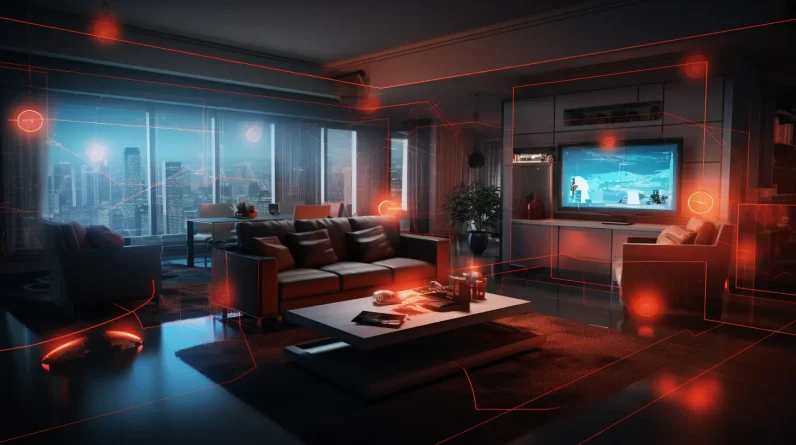
In an era where smart gadgets have become an integral part of our daily lives, the irony lies in the hidden dangers they pose. These seemingly harmless devices, designed to simplify our routines, can inadvertently expose us to privacy breaches, personal data theft, and unauthorized surveillance.
With the ability for hackers to remotely access and control our gadgets, the potential for larger-scale cyberattacks looms. This article sheds light on the alarming vulnerabilities that exist within insecure smart gadgets, urging readers to be cautious and vigilant in their pursuit of technological freedom.
Key Takeaways
– Insecure smart gadgets can lead to privacy breaches and personal data theft, as they fail to protect sensitive information.
– Unauthorized individuals can gain access to sensitive information through vulnerabilities in security systems, resulting in identity theft, financial fraud, and other malicious activities.
– Hackers can gain unauthorized access and control over smart gadgets, rendering them useless or using them as gateways to access other devices and networks.
– Insecure smart gadgets pave the way for unauthorized surveillance and invasion of privacy, as hackers exploit vulnerabilities to gain access to personal information, leading to serious legal implications.
Privacy Breaches and Personal Data Theft
Privacy breaches and personal data theft are serious concerns that arise when insecure smart gadgets fail to adequately protect sensitive information. With the increasing integration of smart gadgets in our daily lives, the risk of data breaches and identity theft has become more prevalent. These gadgets, ranging from smartphones and smartwatches to smart home devices, store vast amounts of personal data, including financial information, health records, and even location data.
Data breaches occur when unauthorized individuals gain access to this sensitive information, putting users at risk of identity theft, financial fraud, and other malicious activities. Hackers can exploit vulnerabilities in the security systems of these gadgets, bypassing encryption and other protective measures. Once access is gained, the stolen data can be used for various nefarious purposes, such as creating fake identities or committing financial fraud.
Identity theft, one of the major consequences of privacy breaches, can have devastating effects on individuals. Personal information, such as social security numbers, bank account details, and credit card information, can be stolen and used to open fraudulent accounts, make unauthorized purchases, or even commit crimes in the victim’s name.
To mitigate the risks associated with privacy breaches and personal data theft, it is crucial for users to take proactive measures to secure their smart gadgets. This includes ensuring regular updates of firmware and software, using strong and unique passwords, enabling two-factor authentication, and being cautious while downloading apps or granting permissions to access personal data.
Remote Access and Control by Hackers
As smart gadgets continue to infiltrate our daily lives, the risk of remote access and control by hackers becomes a pressing concern. These sophisticated cyber criminals can exploit vulnerabilities in our smart devices, allowing them to gain unauthorized access and manipulate our gadgets for malicious purposes.
Here are five alarming dangers associated with remote access and control by hackers:
– Device hijacking and manipulation: Hackers can take control of our smart gadgets, enabling them to manipulate settings, access personal information, and even use the devices for their own nefarious activities.
– Remote code execution: Through remote access, hackers can execute malicious code on our smart gadgets. This can lead to a wide range of damaging consequences, including data breaches, unauthorized surveillance, and even physical harm.
– Device bricking: Hackers can render our smart gadgets useless by remotely disabling or damaging critical components. This not only disrupts our daily lives but also poses a financial burden as we may need to replace the compromised devices.
– Unauthorized access to networks: Once hackers gain control of our smart devices, they can use them as a gateway to access other devices and networks within our homes or workplaces. This can lead to further breaches of privacy and compromise the security of our entire network.
– Exploitation of IoT vulnerabilities: With the increasing adoption of the Internet of Things (IoT), hackers can exploit vulnerabilities in interconnected devices to gain control over multiple gadgets simultaneously. This amplifies the potential damage and increases the scope of their cyber attacks.
It is crucial for users to be aware of these risks and take proactive measures to secure their smart gadgets. Regularly updating software, using strong passwords, and implementing robust security measures can help protect against remote access and control by hackers.
Unauthorized Surveillance and Invasion of Privacy
The rise of insecure smart gadgets has paved the way for unauthorized surveillance and invasion of privacy through the exploitation of vulnerabilities by cybercriminals. As more and more devices are connected to the Internet of Things (IoT), the potential for data privacy breaches and unauthorized access to personal information has become a significant concern.
Smart gadgets, such as home security cameras, voice assistants, and wearable devices, collect vast amounts of data about their users. This data can include personal information, such as names, addresses, and even financial details. When these devices are insecure, they become easy targets for hackers who can exploit their vulnerabilities to gain unauthorized access to this sensitive information.
The invasion of privacy caused by unauthorized surveillance can have serious legal implications. In many jurisdictions, the unauthorized collection, use, and dissemination of personal information are illegal. However, the increasing prevalence of insecure smart gadgets has made it easier for cybercriminals to carry out these activities undetected.
To protect data privacy and mitigate the risk of unauthorized surveillance, it is crucial for users to take proactive measures. This includes regularly updating the firmware and software of their devices, using strong and unique passwords, and being cautious about granting permissions to apps and services.
Lawmakers and regulatory bodies need to establish stricter regulations and penalties to hold manufacturers accountable for producing insecure smart gadgets that put user privacy at risk.
Malware and Ransomware Attacks on Smart Devices
In light of the growing concerns surrounding insecure smart gadgets, the discussion now turns to the significant threat posed by malware and ransomware attacks on these devices. These attacks can have serious consequences, not only for the individual users but also for the security of home and office networks.
Here are five key points to consider:
– IoT device security vulnerabilities: Smart devices are often built with minimal security measures, making them easy targets for hackers. Weak passwords, outdated software, and lack of encryption leave these devices vulnerable to malware and ransomware attacks.
– Impact on home and office networks: Once a smart device is compromised, it can serve as a gateway for hackers to gain access to the entire network. This can result in unauthorized access to sensitive information, financial loss, and even disruption of critical systems.
– Data theft and privacy breaches: Malware and ransomware can collect personal data from smart devices, such as location information, browsing habits, and even audio and video recordings. This stolen data can be used for identity theft, blackmail, or sold on the dark web.
– Financial losses: Ransomware attacks can lock users out of their smart devices until a ransom is paid. This not only leads to financial losses but also encourages the growth of cybercriminal activities.
– Disruption of daily activities: Malware attacks can disable or disrupt the functionalities of smart devices, causing inconvenience and frustration for users.
It is crucial for users to be aware of these risks and take necessary precautions to secure their smart devices, such as regularly updating firmware, using strong passwords, and installing reputable security software. By doing so, individuals can enjoy the benefits of smart gadgets while protecting their privacy and maintaining the security of their networks.
Exploitation of Vulnerabilities for Larger-Scale Cyberattacks
How can the vulnerabilities in insecure smart gadgets be exploited for larger-scale cyberattacks? The impact on critical infrastructure and the potential for IoT botnets are two key aspects to consider.
Insecure smart gadgets, such as Internet of Things (IoT) devices, pose significant risks to critical infrastructure. These devices, which include everything from smart thermostats to industrial control systems, are often riddled with vulnerabilities that can be exploited by cybercriminals. By targeting these vulnerabilities, attackers can gain unauthorized access to these devices and cause significant damage to critical infrastructure systems.
One major concern is the potential for IoT botnets. Botnets are networks of compromised devices that can be controlled by a single entity. By infecting insecure smart gadgets with malware, cybercriminals can recruit them into a botnet, which can then be used to launch larger-scale cyberattacks. These attacks can range from Distributed Denial of Service (DDoS) attacks that overwhelm websites and networks with traffic, to more sophisticated attacks that target critical infrastructure systems.
The impact on critical infrastructure is immense. A successful cyberattack on these systems could disrupt essential services such as power grids, transportation systems, and communication networks. The potential for widespread disruption and chaos is a serious concern.
Frequently Asked Questions (FAQs)
How Can I Protect My Personal Data From Privacy Breaches and Theft When Using Smart Gadgets?
To protect personal data from privacy breaches and theft when using smart gadgets, it is crucial to implement security measures such as strong passwords, regular software updates, and encryption. By securing smart devices, individuals can safeguard their personal information and maintain their privacy.
What Are Some Signs That My Smart Device May Be Under Remote Access and Control by Hackers?
Some signs of remote access in smart devices include unusual behavior, increased data usage, and unexplained changes in settings. To secure your gadgets, update firmware regularly, use strong passwords, and enable two-factor authentication.
Can Smart Gadgets Be Used for Unauthorized Surveillance and Invasion of Privacy?
Smart gadgets have the potential to be used for unauthorized surveillance and invasion of privacy, raising legal and ethical concerns. Understanding the laws and regulations governing their use is crucial to protecting individual freedoms and ensuring responsible usage.
What Are the Common Types of Malware and Ransomware Attacks on Smart Devices?
Common types of malware and ransomware attacks on smart devices include phishing, malware-infected apps, and malicious Wi-Fi networks. Ensuring smart device security is crucial, as well as regularly updating software to protect against emerging threats.
How Can the Exploitation of Vulnerabilities in Smart Gadgets Lead to Larger-Scale Cyberattacks?
The exploitation of IoT vulnerabilities in smart gadgets poses a significant threat to the overall cybersecurity landscape. It enables hackers to gain unauthorized access, compromising personal data and potentially leading to larger-scale cyberattacks with devastating consequences.
Conclusion
The proliferation of insecure smart gadgets poses hidden dangers that threaten our privacy and security. From privacy breaches and personal data theft to unauthorized surveillance and invasion of privacy, the risks are numerous.
The potential for malware and ransomware attacks on smart devices, as well as the exploitation of vulnerabilities for larger-scale cyberattacks, further underline the need for greater security measures.
As we continue to embrace the convenience of smart technology, it is crucial to remain vigilant and prioritize the protection of our personal information.







